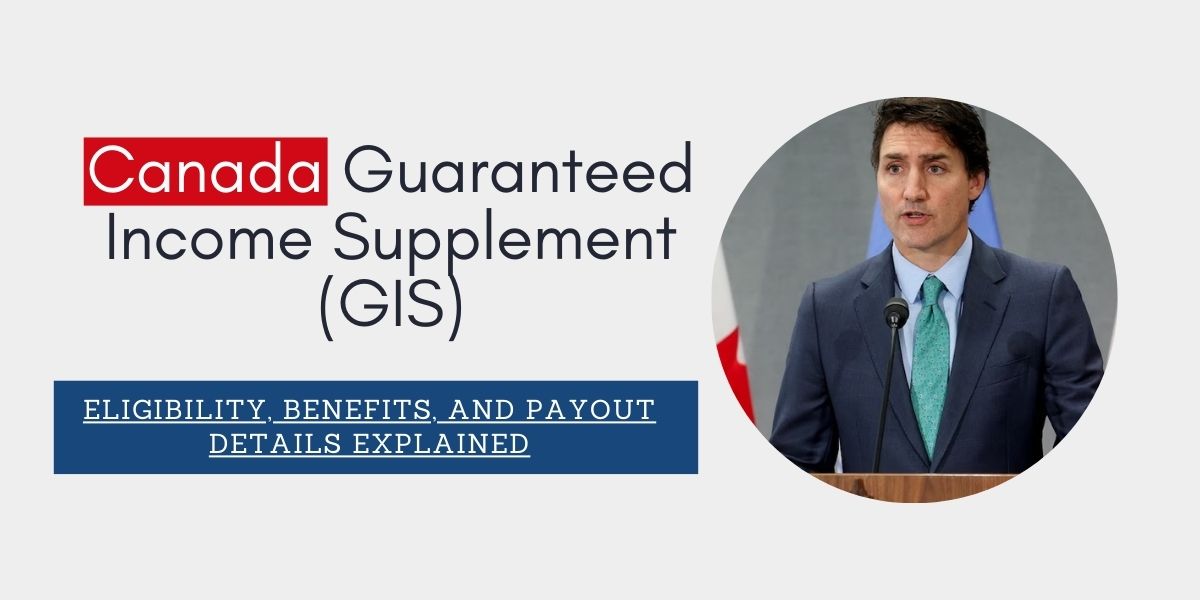Canada Guaranteed Income Supplement (GIS) helps low-income seniors in Canada with extra financial support. Single seniors can get up to $10,997 each year, while couples can receive up to $13,239. For every dollar you make over $3,500 for singles or $5,700 for couples, your benefits go down by 50 cents.
Canada Guaranteed Income Supplement
The Canada Guaranteed Income Supplement (GIS) is a key financial aid program run by Canada’s Service Canada. It’s designed to add extra support to the Old Age Security (OAS) pension, helping seniors with low incomes who live in Canada.
| Important Links |
|---|
| SASSA Pension Dates July-August 2024 |
| Centrelink $1,500 Payment 2024 |
| Canada Minimum Wage 2024 |
For those who qualify, the maximum yearly GIS payment is $10,997 for individuals and $13,239 for couples where both partners receive OAS. For individuals and couples over $3,500 and $5,700, the GIS amount decreases by 50 cents.
Income from Old Age Security (OAS), money taken out of a Tax-Free Savings Account (TFSA), and the one-time $200 COVID-19 payment in 2020 don’t count toward your income total. Those who receive OAS might receive a letter from Service Canada explaining how to apply for the Guaranteed Income Supplement (GIS).
Eligibility criteria for Canada Guaranteed Income Supplement
Eligibility for benefits primarily depends on your net income, which varies based on your marital status. Service Canada considers your total income for the year, including:
- Employment Income: Wages, salaries, and commissions
- Pension Income: Both private and public pensions
- Investment Income: Interest, dividends, and capital gains
Note: The Old Age Security (OAS) pension itself isn’t counted as income for the Guaranteed Income Supplement (GIS).
Income Limits
For Single, Widowed, or Divorced Individuals
- Net Income Limit: Must be under $21,768 per year.
For Married or Common-Law Partners
- Combined Net Income Limits:
- $28,752 if your spouse/partner receives the full OAS pension.
- $52,176 if your spouse/partner does not receive an OAS pension.
- $40,272 if your spouse/partner receives the Allowance (a benefit for spouses or common-law partners aged 60 to 64 of someone receiving the GIS).
Income Changes
The GIS is based on the income you reported from the previous tax year. However, if your income has dropped significantly, such as after retirement or changes in pension income, Service Canada may use an estimate of your current income to determine your eligibility.
By understanding these income limits and how net income is assessed, you can better determine your eligibility for benefits and take appropriate action if your financial situation changes.
Amount of Canada’s Guaranteed Income Supplement
What Affects the GIS Amount?
- Marital Status: How much Canada Guaranteed Income Supplement you receive can vary based on whether you’re single, widowed, or divorced. People in these situations usually get a higher maximum GIS amount compared to those who have a spouse or common-law partner who also receives Old Age Security (OAS) pension.
- Net Income: GIS is meant to add to your income, but the amount you get decreases as your net income goes up. If your income exceeds certain limits, your GIS payment might gradually go down or stop altogether.
Maximum GIS Amounts:
If you’re single, widowed, or divorced, you could receive up to $1,072.93 per month in Guaranteed Income Supplement (GIS) if your yearly net income is below $21,768.
For those who are married or living with a common-law partner, the maximum GIS amount depends on your partner’s Old Age Security (OAS) pension:
| Partner’s OAS Pension Status | Monthly Benefit | Combined Yearly Income Limit |
|---|---|---|
| Full OAS Pension | Up to $645.84 | Under $28,752 |
| No OAS Pension | Up to $434.94 | Below $52,176 |
| Allowance (for spouses/common-law partners aged 60 to 64 of someone receiving GIS) | Up to $829.24 | Under $40,272 |
Annual Adjustments: The GIS amount is reviewed and adjusted four times a year—in January, April, July, and October—to reflect changes in the cost of living as measured by the Consumer Price Index (CPI).
Non-Taxable Benefit: The GIS you receive is non-taxable, meaning you don’t have to pay income tax on it in Canada.
What to Do If Your Canada Guaranteed Income Supplement is Delayed
If your GIS payment is delayed, here’s what you can do:
Give It Some Time:
- Application Processing: If you’ve recently applied for GIS, it usually takes 4-8 weeks to process. Delays can happen if your application was incomplete or if more verification is needed.
- Annual Adjustments: GIS payments are adjusted every January, April, July, and October. After these adjustments, there might be a short delay before you get the updated amount.
If the Delay is Longer Than Expected:
- Contact Service Canada: If your payment is overdue and you haven’t heard anything, give Service Canada a call at 1-800-622-6232.
- Explain the Situation: Let them know the expected payment date, when you last received your GIS, and if you’ve had any recent updates from them.
By following these steps, you should be able to get a clearer picture of what’s causing the delay and how to resolve it.

